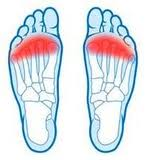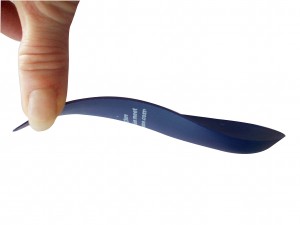 Does your job require you to stand and/or walk extensively? Are you pregnant or overweight? Are you a runner or athlete that repetitively puts pressure on your forefoot? Are you a woman who wears high heels constantly? If you answered “yes” to any of these questions, then you’re at risk of developing metatarsalgia.
Does your job require you to stand and/or walk extensively? Are you pregnant or overweight? Are you a runner or athlete that repetitively puts pressure on your forefoot? Are you a woman who wears high heels constantly? If you answered “yes” to any of these questions, then you’re at risk of developing metatarsalgia.
Metatarsalgia is a type of neuralgia that is caused by compression of the nerves that runs between the metatarsal bones in the ball of your foot. With every step, the nerves are pushed and rubbed between the bones, causing inflammation and pain. Eventually, scar tissue forms to protect the nerve fibers in the surrounding nerve tissue. Metatarsalgia can develop under one or all metatarsal heads. Some people describe this pain like “walking on pebbles.”
Metatarsalgia is a common overuse injury caused by persistent and abnormal weight distribution on the forefoot, which explains why athletes, dancers, pregnant women, and obese individuals are at risk for developing it. It also occurs when women frequently wear high heels that force the woman’s weight onto the toes that are often restricted within a narrow toe box of the shoe. Most commonly, older adults, who suffer from a loss of fatty tissue that causes a lack of padding in the area of the metatarsals, will develop metatarsalgia.
Symptoms and Diagnosis
Some symptoms include:
- Sharp, aching, or burning pain in the ball of your foot.
- Sharp or shooting pain in the balls of your feet and/or your toes.
- Numbness or tingling in the balls of your feet and/or your toes.
- Pain that worsens when you stand, walk, or run.
- Pain that worsens when you flex your feet during walking or running.
- Pain when wearing heels 2” or more.
If metatarsalgia is left untreated, it may lead to:
- Pain in other parts of the same or opposite foot.
- Pain in the hips or lower back because of limping due to foot pain.
Since these symptoms are similar to other foot problems, you should consult your doctor for a diagnosis. Your doctor will ask you questions about your lifestyle and examine your foot. You may also need an X-ray to rule out other conditions.
Treatment and Prevention
Some common treatments to relieve metatarsalgia pain:
- Rest your foot and avoid high-impact exercises like running.
- Apply ice to the affected area for 20 minutes several times a day.
- Take an over-the-counter pain reliever, like Ibuprofen, to reduce pain and inflammation.
- Maintain a healthy weight to decrease pressure on your forefoot.
- Wear properly fitted shoes with a wide toe box. Avoid wearing high heels or shoes that are too small.
- Use a metatarsal pad in your shoes to reduce forefoot pressure.
 Consider wearing arch supports or custom orthotics, like ezWalker® Performance Insoles. These insoles minimize the stress on your metatarsal bones by supporting your arches and reducing the pressure on the balls of your feet. The ezWalker® insoles are customized to the contours of your feet and are biomechanically designed to enhance your gait to lessen stress and strain as you walk. You’ll experience pain relief in your feet, knees, hips, and lower back. The ezWalker® insoles are ultra thin and ¾ in length, so they fit easily into your shoes for custom-made comfort. Because no two feet are alike, a custom fit is always the best fit.
Consider wearing arch supports or custom orthotics, like ezWalker® Performance Insoles. These insoles minimize the stress on your metatarsal bones by supporting your arches and reducing the pressure on the balls of your feet. The ezWalker® insoles are customized to the contours of your feet and are biomechanically designed to enhance your gait to lessen stress and strain as you walk. You’ll experience pain relief in your feet, knees, hips, and lower back. The ezWalker® insoles are ultra thin and ¾ in length, so they fit easily into your shoes for custom-made comfort. Because no two feet are alike, a custom fit is always the best fit.
For more information about ezWalker® Performance insoles and how you can order your pair today, visit our website.
Put an ezWalker® in your shoes and put a smile on your face. Because … when your feet feel good, you feel good.
Note: If you follow these guidelines and your pain persists, you may have a more serious condition. See your physician for a more complete diagnosis and treatment.

